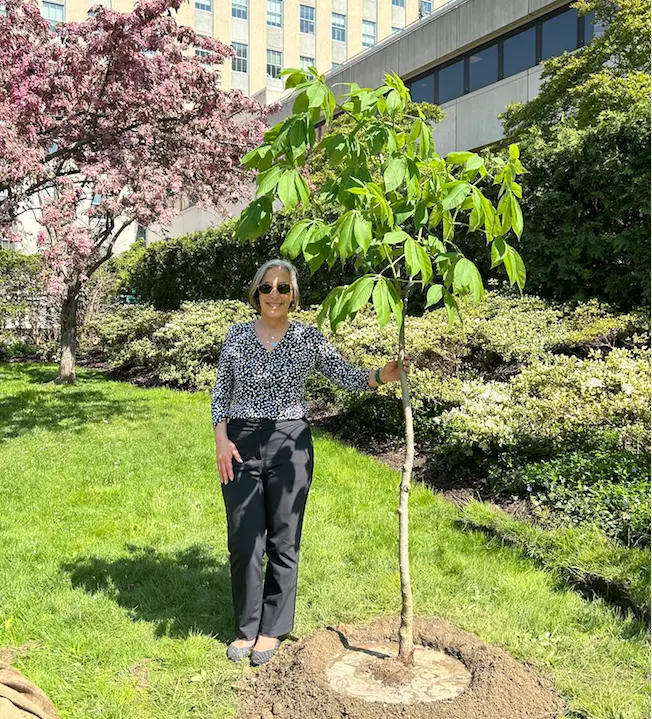In “The Diary of a Young Girl,” Anne Frank wrote three times about a tree that was growing outside of the house in which she and her family were hiding from the Nazis in Amsterdam while World War II was raging. On Feb. 23, 1944, Anne Frank wrote, in part: “Nearly every morning I go to the attic to blow the stuffy air out of my lungs, from my favorite spot on the floor I look up at the blue sky and the bare chestnut tree, on whose branches little raindrops shine, appearing like silver.”
Now, an offspring of the estimated 150- to 170-year-old European Horse Chestnut tree that provided so much optimism and beauty to Anne Frank is growing in White Plains. It is at the Garden of Remembrance Holocaust Memorial on Martine Avenue. The sapling is one of many that have been grown from chestnuts that were harvested from the original tree and germinated. The saplings have been distributed around the world by the Anne Frank Center and to selected sites in the U.S. by the Anne Frank Center USA. One of the saplings was planted in front of the U.S. Capitol in 2014. 
Mille Jasper and Anne Frank sapling.
Millie Jasper, executive director of the Holocaust & Human Rights Education Center (HHREC) in White Plains, told the Business Journal, “It’s now more than six feet tall and it’s in the Garden of Remembrance and on June 11 we’re going to have a dedication. It was delivered and planted last week.”
The European Horse Chestnut that fascinated Anne Frank in Amsterdam had been blown down in a storm in 2010 after having been weakened over several decades by disease. Some people had fought to save the tree and nurse it along, while others feared it might fall and cause damage to property or hurt someone. They went to court seeking permission to cut it down. Mother Nature wound up resolving the tree’s fate, but also ensured that its offspring could survive in the hands of caring people.
“The Anne Frank Center gathered the saplings and year after year has been giving out the saplings,” Jasper said. “There were just a few left and we got one.”
The HHREC and Westchester Jewish Council on May 6 held a Yom HaShoah Holocaust commemoration at the Garden of Remembrance. The commemoration came at a time when incidents of antisemitism have been on the rise in the U.S. and globally. Some Torahs that were rescued from the holocaust were carried in a procession during the commemoration.
Anna Leiser-Kleinhaus, a holocaust survivor who participated in the event said, “The immensity of this catastrophe for the Jewish people is engrained in the memory of those who survived the horrors of that period. For me it represents a nightmare with haunting memories of murders of members of my family and the terror that marred my childhood.”


The holocaust commemoration took place shortly before HHREC’s Annual Spring Luncheon on May 9 at Bet Am Shalom Synagogue in White Plains. HHREC’s Director of Education Steven Goldberg was scheduled as the featured speaker, addressing the subject of how the swastika became a symbol of hate. It dates from as far back as an estimated 7,000 years ago and served over time as a religious symbol. It represented peace and good luck long before being adopted by Adolf Hitler as a symbol of his Nazi Party and the hatred, discrimination and violence it embraced. Goldberg takes his presentation on the swastika into schools and also educates educators on the symbol’s history and transformation.
“Language verbal and nonverbal and symbols are very important,” Jasper said. “It’s something that we teach the teachers to explain to the kids. When they see a swastika etched somewhere is it just a kid doodling or its it somebody who says ‘I do identify with Nazi ideology?’ We need to know. A noose is the same thing. Sometimes kids will be drawing a noose and just trying to get the wrapping just right as in ‘how do you draw that?’ Other times it becomes a hate symbol because that is their intention.”



















